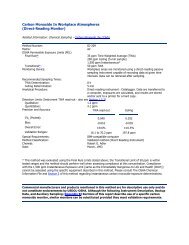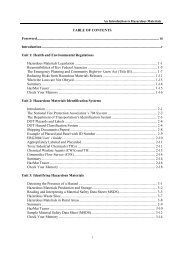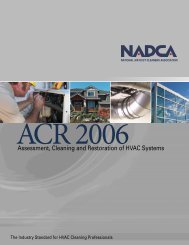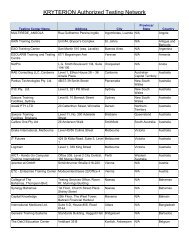Dampness and Mould - WHO guidelines for indoor air quality - PRWeb
Dampness and Mould - WHO guidelines for indoor air quality - PRWeb
Dampness and Mould - WHO guidelines for indoor air quality - PRWeb
Create successful ePaper yourself
Turn your PDF publications into a flip-book with our unique Google optimized e-Paper software.
64<br />
<strong>WHO</strong> GUIDELINES FOR INDOOR AIR QUALITY: DAMPNESS AND MOULD<br />
published studies on selected outcomes. The review focuses on selected categories<br />
of the outcomes included in the Institute of Medicine review (upper respiratory<br />
tract symptoms, cough, wheeze, dyspnoea, asthma symptoms in people with<br />
asthma, asthma development) <strong>and</strong> several additional categories (current asthma,<br />
respiratory infections, bronchitis, wheeze, allergic rhinitis <strong>and</strong> allergy or atopy).<br />
It excludes outcomes on which limited research has been reported (e.g. effects<br />
related to skin, eyes, fatigue, nausea, headache, insomnia, mucous membrane irritation<br />
<strong>and</strong> sick-building syndrome).<br />
4.1.2 Methods<br />
The online database PubMed was searched up to July 2007 <strong>for</strong> published articles,<br />
by using three groups of keywords, such as: (1) dampness, damp, water damage,<br />
moisture, humidity, fungi, fungus, mould, bacteria or microorganisms; along<br />
with (2) health, asthma, allergy, eczema, wheeze, cough, respiratory, respiratory<br />
infection, lung, skin, nasal, nose, hypersensitivity pneumonitis, alveolitis, bronchial,<br />
hypersensitivity or inflammation; <strong>and</strong> with (3) building, house, home, residence,<br />
dwelling, office, school or day-care centre. Some combinations of terms<br />
were searched separately. References in review articles or in personal databases<br />
were also included. Other references were added, as available.<br />
For inclusion in this review, a study had to meet the following criteria:<br />
publication in a peer-reviewed journal (printed or online);<br />
reporting of original data from a study that was either an experimental intervention,<br />
a prospective cohort, a retrospective cohort or case-control, a crosssectional<br />
or a cross-sectional case-control study;<br />
no minimum study size, except that if exposure was characterized only at<br />
building level, at least 10 buildings had to be included;<br />
it included risk factors related to dampness, fungi or microbiological components<br />
or products, other than allergens – such as those related to dust mites,<br />
cockroaches <strong>and</strong> mice;<br />
it included upper respiratory tract symptoms, cough, wheeze, dyspnoea,<br />
imp<strong>air</strong>ed lung function, allergy or atopy, asthma symptoms in people with<br />
asthma, asthma development, any diagnosis of asthma, current asthma, hypersensitivity<br />
pneumonitis, respiratory infections or bronchitis; <strong>and</strong><br />
it provided adequate control, through the study design or analytical strategies,<br />
of selection bias <strong>and</strong> confounding by key variables: sex, active smoking (in<br />
studies of adults), passive smoking (in studies of children) <strong>and</strong> socioeconomic<br />
status (except in the Nordic countries).<br />
Exposures <strong>and</strong> conditions that were not included were dust mites, humidity <strong>and</strong><br />
measurements of moisture in mattresses. Endotoxins are components of Gramnegative<br />
bacteria that may favour moist surface conditions, but they are also






